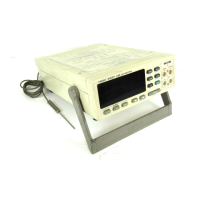.3.8 Output Queue
When several compound commands have a common head portion, (for example
:CSET:TABLe and :CSET:TMODe) only when writing them directly following
on from one another, this common portion (:CSET: for example) can be omitted
from each command except for the first one. This common portion is called
"the current path", by analogy with the general concept of the current
directory in the directory structure of UNIX or MSDOS, and until it is cleared
the analysis of following commands is performed by deeming them to be
preceded by the current path which has been curtailed in the interests of
brevity. This manner of using the current path is shown in the following
example.
(1) Normal expression
":CSET:TABLe 1;:CSET:TMODe AUTO"
(2) Abbreviated expression
" :CSET:
TABLe 1;TMODe AUTO"
This becomes the current path, and can be curtailed from the following
commands.
The current path is cleared when the power is turned on, when a system reset
is performed by key input, when a colon ":" appears at the start of a command,
and when a message terminator is detected.
・ The messages of the common command form can be executed without relation
to the current path. Further, they have no effect upon the current path.
・ It is not necessary to prefix a colon ":" at the start of headers of the simple
commands and the compound commands. However, in order to prevent the
confusion with the abbreviated forms and mistakes in operation, it is
recommended practice always to prefix ":" to headers.
The response messages accumulated in the output queue and are read out as
data and cleared by the controller.
The output queue is also cleared in the following circumstances.
・When a device clear is issued.
・When the power is turned on.
・When the unit is reset by a key press (system reset).
・When the query error is generated.
The 3227 has an output queue of 400 bytes capacity. If the response messages
overflow this limit, a query error is generated, and the output queue is
cleared. Further, if a new message is received while the output queue
still contains any data, the output queue is cleared, and a query error is
generated.

